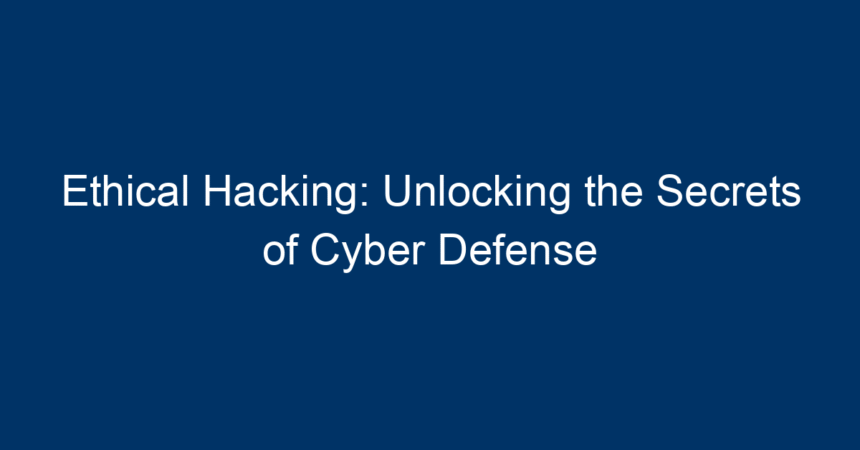In today’s interconnected world, the lurking threats in cyberspace have become more sophisticated than ever. As traditional security measures falter against cunning cybercriminals, the demand for skilled professionals who can safeguard systems from potential breaches grows. Enter ethical hacking—a proactive approach to cybersecurity that involves legally and ethically testing systems to identify vulnerabilities before malicious hackers exploit them. In this article, we delve into the world of ethical hacking, exploring its significance, methodologies, and how you can embark on a journey to become an ethical hacker yourself.
Understanding Ethical Hacking
What is Ethical Hacking?
At its core, ethical hacking refers to the practice of intentionally probing systems, networks, and applications to uncover security vulnerabilities. Unlike malicious hackers—often termed “black hats”—ethical hackers, or “white hats,” work within legal boundaries and with the permission of the system owners. This ethical practice aims to strengthen defenses and prevent future cyberattacks.
The Importance of Ethical Hacking in Cybersecurity
With data breaches making headlines daily, the importance of ethical hacking can’t be overstated. Organizations increasingly recognize the value of identifying vulnerabilities before they can be exploited. Ethical hackers serve as the first line of defense, helping businesses protect sensitive data, maintain customer trust, and comply with regulations.
Core Principles of Ethical Hacking
1. Permission
A fundamental principle of ethical hacking is obtaining explicit permission from the system owner before conducting any security assessments. This not only ensures legal compliance but also fosters a collaborative environment where both parties can work together to enhance security.
2. Knowledge and Skills
Ethical hackers must possess a comprehensive understanding of networks, operating systems, and various security protocols. They utilize both technical skills and creative thinking to emulate the tactics of malicious hackers, thereby identifying weaknesses.
3. Reporting and Remediation
Once vulnerabilities are identified, ethical hackers must document their findings and provide actionable recommendations for remediation. This includes outlining the potential impact of each vulnerability and suggesting ways to mitigate risks.
Types of Ethical Hacking
1. Penetration Testing
Penetration testing, or pen testing, simulates real-world attacks to uncover security weaknesses. Ethical hackers use various tools and techniques to exploit vulnerabilities, helping organizations understand how an attacker might breach their defenses.
2. Social Engineering Testing
Social engineering tests focus on the human element of security. Ethical hackers simulate phishing attacks or other manipulative tactics to assess an organization’s awareness and resilience against social engineering threats.
3. Network Security Assessment
This involves evaluating an organization’s network infrastructure for vulnerabilities. Ethical hackers examine routers, switches, and firewalls to ensure they are properly configured and secured against potential breaches.
4. Web Application Testing
As online services proliferate, web application testing has become crucial. Ethical hackers assess the security of web applications, looking for vulnerabilities such as SQL injection, cross-site scripting (XSS), and more.
Tools of the Trade
Ethical hackers utilize a variety of tools to assist in their assessments. Some popular tools include:
Nmap
Nmap is a network scanning tool that provides detailed information about hosts and services on a network. It helps ethical hackers identify open ports, running services, and potential vulnerabilities.
Metasploit
A powerful framework for penetration testing, Metasploit allows ethical hackers to exploit known vulnerabilities in systems. It provides an array of exploits and payloads essential for simulating attacks.
Wireshark
This packet analyzer helps ethical hackers capture and analyze network traffic for suspicious activity or vulnerabilities. It’s an invaluable tool for network security assessments.
Burp Suite
Burp Suite is a popular platform for web application security testing. It offers tools for scanning applications for vulnerabilities, including automated scanners and manual testing utilities.
The Ethical Hacking Process
1. Planning and Preparation
The first step involves defining the scope of the ethical hacking engagement. This includes outlining goals, identifying the systems to be tested, and obtaining necessary permissions.
2. Information Gathering
Ethical hackers gather information about the target system, such as domain names, IP addresses, and network architecture. This phase is crucial for understanding the landscape before testing begins.
3. Vulnerability Assessment
Once information is gathered, ethical hackers use various tools to scan for known vulnerabilities and misconfigurations in the system.
4. Exploitation
In this phase, ethical hackers attempt to exploit identified vulnerabilities to determine the extent of the potential damage. This is where they assess how a malicious actor could breach the system.
5. Reporting
After the assessment, ethical hackers compile their findings into a comprehensive report. This document outlines vulnerabilities, potential risks, and actionable recommendations for remediation.
6. Retesting
Ethical hackers may perform retesting to verify that vulnerabilities have been remediated effectively. This reinforces the importance of an ongoing security posture.
Getting Started in Ethical Hacking
1. Education and Training
To become a successful ethical hacker, formal education in cybersecurity or information technology can be advantageous. Many universities and online platforms offer specialized courses in ethical hacking.
2. Certifications
Certifications play a crucial role in establishing credibility in the field. Some respected certifications include:
- Certified Ethical Hacker (CEH): A widely recognized certification covering various aspects of ethical hacking.
- Offensive Security Certified Professional (OSCP): A hands-on certification focused on penetration testing.
- CompTIA Security+: A foundational certification in cybersecurity concepts.
3. Build Experience
Consider working on real-world projects, participating in bug bounty programs, or joining cybersecurity competitions such as Capture the Flag (CTF) events. Practical experience is invaluable.
4. Stay Current
The cybersecurity landscape is constantly evolving; therefore, staying current with industry trends, vulnerabilities, and new tools is essential. Follow reputable blogs, attend conferences, and participate in online forums.
Conclusion: The Future of Ethical Hacking
As the digital landscape continues to expand, the need for ethical hacking will only increase. Organizations recognize that proactive measures are far more effective than reactive responses to cyber threats.
By understanding the principles and practices of ethical hacking, individuals and businesses can better empower themselves against potential cyberattacks. Whether you’re a budding cybersecurity professional or part of an organization looking to bolster your defenses, embracing ethical hacking is a pivotal step in safeguarding valuable information.
Engage in training, earn certifications, and continuously seek knowledge in this dynamic field. The journey of ethical hacking not only strengthens the digital realm but also fosters innovation and resilience in the face of emerging threats.
In a world where data is currency, ethical hacking is the key to unlocking the secrets of cyber defense, ensuring that organizations and individuals remain safe in an increasingly perilous digital landscape.




